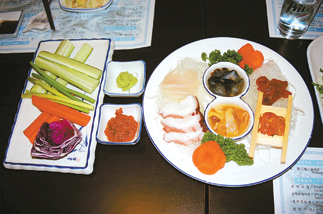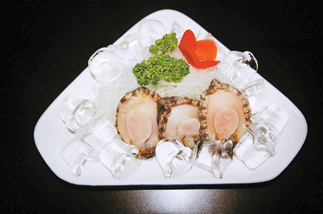Fruits of the sea found deep in the city’s center

Neptune’s bounty: served fresh and raw By Andy Salmon
Few know this better than former abalone diver Choi Seong-tae. For years, this stocky gent with the big smile braved the seas off Jeolla Island, renowned for its cold, dark waters and the ultimate marine predator ― the great white shark. (There have been a number of fatal attacks off Jeolla over the years, the last in 1996, though tourism authorities are not keen to publicize this.)
Perhaps because of his background, Choi has come to an appreciation of the finest fodder the ocean floors have to offer. And perhaps also due to the perils of the deep, he no longer dives for a living: He gets his seafood at 6 a.m. every day at the Noryangjin Fish Market, where the only sharks are sliced on ice (although they have been spotted in the nearby financial center of Yeouido). He also maintains contacts along the coast, who keep him appraised of good stuff when they have it.
Today, he is the owner of one of the capital’s most famed seafood restaurants, Haecheon. This establishment has been patronized by stars, from Bae Yong-joon on downwards ― Choi consulted for the opening of Yonsama’s restaurant in Japan ― as well as some very high-profile business figures.
They don’t come for the chic interiors. The place is up a poky staircase, boasts a dark and nondescript main dining room and a range of private rooms of various sizes, all with brown and gold decor. No, the food is the thing.
But if you are expecting the kind of menu you would find in a coastal restaurant in Cape Cod, say, or Cornwall ― fried whitebait, lobster with butter sauce, battered sole with a wedge of lemon ― think again.
Koreans share their East Asian neighbors’ universal appetite for seafood. Haecheon’s flagship dish ―which must be ordered at least a day in advance ― begins with a range of ocean dwellers of various shapes, colors, sizes and textures. Served raw.
Our banquet begins with three large, fresh, raw abalones surrounded by ice cubes. These large, rubbery mollusks are reputedly good for the liver, but this does not explain why East Asians are so crazy about them, and why divers in places like South Australia and Northern California run such risks to pry them from cold, dark rocks, far underwater.

Raw abalone
Fortunately, there is more. Alongside a plate of cut cucumber, carrot and garlic stalks is a platter of deliciously fresh oysters in vinegar and soy sauce, with a bed of seaweed. Then it is sea cucumber, sea urchin (mulched and de-spiked) ― surprisingly tasty ― as well as some other bottom dweller which nobody quite recognizes. Then a plate of octopus tentacles, gently steamed. The octopus bodies are stuffed with semi-cooked rice, creating a great texture. There is also a sashimi salad with spicy sauce, and a seaweed, lettuce and seafood salad, drizzled in sesame oil; a very pleasing combination.
Haecheon’s flagship arrives at last. It is, I suppose, the local equivalent of surf ’n’ turf: abalone and chicken stew. Cooked at the table it proves surprisingly savory, as the abalone-tinted brine imbues the fowl with a fishy flavor. (And yes, cooked abalone is a lot more acceptable to the Western palate than the raw stuff.) Finally, rice is added to the remaining stock to create a chicken, seaweed and abalone porridge. My liver feels better already.
Speaking of healthy livers, my one complaint about this place is the lack of international grog. I would really have liked to have sunk a vessel or two of decent wine or sake with seafood of this quality, but alas, the menu offers nothing of the sort, only the usual selection of local spirits.
Irritatingly, the menu has no prices on it, but we were pleasantly surprised at the bill. The stew (and side dishes) come to 120,000 won, and serves four comfortably. Considering the quality and quantity of the oceanic bounty served up, this is good value. (I should add, here: Please don’t expect what we had. Bar the main dish, what is served all depends on what the market has each day.)
Verdict: If you are a connoisseur of Asian-style seafood, you will love this place. But if you are more of a fish ’n chips type? Go on, try it once. Just for the experience.
Haecheon
English: English menu, none spoken
Tel: (02) 790-2464 / 793-7415
Address: Hannam-Dong 682-1, Yongsan district, Seoul (There is no English singage, only Chinese characters: it is on the second floor above the Western restaurant Toque.)
Subway: Hangangjin, line 6
Parking: Available next to the tall, dark glass building further down the street
Hours: 10 a.m. to 10:30 p.m.
Dress: Come as you are
By Andrew Salmon Contributing Writer [andrewcsalmon@yahoo.co.uk]










with the Korea JoongAng Daily
To write comments, please log in to one of the accounts.
Standards Board Policy (0/250자)